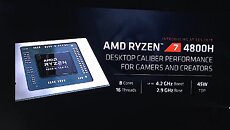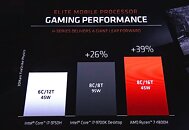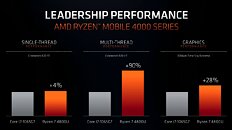Monday, January 6th 2020

AMD Announces Ryzen 4000 Mobile Processors: 4800U and 4800H
AMD today announced its Ryzen 4000-series mobile processors designed to compete with Intel's fastest, across both its 10th gen "Ice Lake" and "Comet Lake" mobile processors lines. At the heart of these processors is the 7 nm "Renoir" silicon, which doubles the CPU core count over the previous generation "Picasso," and improves IPC (single-thread performance) by a double-digit percentage. "Renoir" combines a CPU with 8 cores based on the "Zen 2" microarchitecture, with an iGPU that has the number-crunching machinery of "Vega," but with display- and multimedia-engines of "Navi." It is a monolithic piece of silicon with a dual-channel IMC that supports not just conventional DDR4 memory, but also fast LPDDR4X.
There are two distinct classes of Ryzen 4000 Mobile: U and H. The Ryzen 7 4800U, with its 15 W TDP, targets ultra-portable notebooks, and goes head-on against Intel's Core i7 "Ice Lake-U" processors, winning on the CPU front with its high core-count and IPC. The Ryzen 7 4800H, on the other hand, taps into the 45 W TDP headroom to dial up CPU and iGPU clock-speeds significantly, offering CPU performance that beats the desktop Core i7-9700K. It also introduces SmartShift, an iGPU + dGPU virtualization technology that lets your notebook dynamically switch between the two based on graphics load.
There are two distinct classes of Ryzen 4000 Mobile: U and H. The Ryzen 7 4800U, with its 15 W TDP, targets ultra-portable notebooks, and goes head-on against Intel's Core i7 "Ice Lake-U" processors, winning on the CPU front with its high core-count and IPC. The Ryzen 7 4800H, on the other hand, taps into the 45 W TDP headroom to dial up CPU and iGPU clock-speeds significantly, offering CPU performance that beats the desktop Core i7-9700K. It also introduces SmartShift, an iGPU + dGPU virtualization technology that lets your notebook dynamically switch between the two based on graphics load.





53 Comments on AMD Announces Ryzen 4000 Mobile Processors: 4800U and 4800H
However, a Dell G5 with a 4800H and possibly a 5600M or 5700M? Most likely a great successor to my aging G5 5587.
Possibly ~20% less power consumption than a i7-8750H/i7-9750H, ~10°C cooler than those mentioned chips and paired with a 5600M/5700M, drop it into one of those newer Razer Blade 15 chassis (the one that can do 70°C full load) or Dell G5 5587 (this thing can take 100°C, tried and tested), keep it at 5 to 6 lbs and sell it for $1,199.00.
I would empty my wallet for one.
One has the fastest IGP ever, the other has (more or less) a 4.5 year old IGP that wasn't the fastest even at launch in 2015. Not even Intels fastest back then.
2015: The 65 W CPU beats the 95 W CPU by 30 %.
On the laptop marked amd has the lead, desktop, HEDT and server as well. 2020 going to be a very tough year for Intel with marked share loss and loss in income. Maybe by 2021 Intel stand a chance when they are coming with 10 nm, but until then, Intel is not gonna be much of a thread to amd in 2020.
The LPDDR4X support alone is a massive improvement for IGPUs.
Some of the old crap-tops were running god forbid 2133 and 2666 memory. LPDDR4X can reach 4266 easily.
Vega itself was very bandwidth limited and doesn't scale well with more CUs, so a leaner GPU but higher clock speed with 7nm could be a significant improvement.
There are APU overclock results on HWbot and they show that Vega 8 and Vega 11 CUs are very close in performance.
Same as 4800U, there are also rumors that R9 mobile is also being made(?) & will be unveiled when the time comes. Presumably 16c at the top end, this thing will be a giant killer of sorts :laugh:AMD quietly stopped supporting CPU-type Compute Devices of OpenCL. The problem was detected in December 2019 on ASUS TUF FX505DU Gaming Notebook. Initially, it was considered as a problem of ASUS but actually this is Not the case. During recent visit to a nearby BestBuy store the problem was easily seen on MSI and Acer Gaming and HP Envy Notebooks. We contacted AMD Tech Support and all our attempts to bring attention of that problem to AMD's Software Engineers failed. Tech support from AMD's Level 1 ( L1 ) couldn't reproduce the problem and bounced us in a very disrespectful way: "...Since we can't reproduce the problem this is Not our problem...".
It means, that in case of a system with:
- AMD Ryzen Mobile CPUs up to ~500 GFLOPs ( ~0.5 TFLOPs ) of processing power is Not available for OpenCL based processing
- AMD Ryzen Desktop CPUs more than 2 TFLOPs of processing power is Not available for OpenCL based processing
- AMD Epyc Server CPUs more than 4 TFLOPs of processing power is Not available for OpenCL based processing
That's a Lot of Processing Power and, unfortunately, AMD doesn't care about it!
Quality of OpenCL support from AMD went to the lowest level since 2015-2016 years and a recent AMD Display driver 26.20.11016.1 disabled NVIDIA's OpenCL support on an ASUS Gaming system. AMD's 26.20.11016.1 driver was rollbacked to a driver from AMD Adrenalin 19.9.2 package.
Also, AMD stopped supporting AMD Accelerated Parallel Processing SDK ( aka AMD APP SDK ) and the SDK was also quietly removed from the AMD's website. All attempts to bring back The Best SDK for OpenCL programming failed.
At the same time NVIDIA and Intel continue to support OpenCL and on Dell Precision Mobile workstations all types of OpenCL Compute Devices are available for processing.
We really wanted to upgrade hardware to systems with AMD CPU's ( a resolute move from Intel CPUs ) but due to all these negative discoveries all upgrades are on hold...
45W* APU lineup
*Asus has the best bin of the 4800H exclusively for 6 months as the 4800HS at 35W and the same performance.
These things are going to kick Intel's butt. (As long as they actually get them out there.) While I would love even more iGPU power, I'm mightily impressed that they are outperforming the old iGPUs with significantly fewer CUs. I would definitely love a 25W cTDP 4800U or 4700U thin-and-light with a 120Hz IPS FreeSync display. Please, anyone?I agree, but apparently the clock speed bump and increased memory bandwidth combine to make it significantly faster than the old 11CU chips. H parts have fewer CUs as OEMs don't seem to want to run them without a dGPU, sadly.
There must be a reason behind all this, I just can't see it.
also seems like NV should be worry, since Intel chose to go all in on the AI with GPUs were NV leads.4800H is intended to pair up with dGPU, so less focus on the iGPU.
Also lover clocks to give bigger TDP budget to the CPU.
Both 4800U and 4800H are capped at 4200Mhz turbo.
Of course there's also room for a Ryzen 9 in there when they do it like this. I for one would love a slim 45W-powered iGPU monster laptop, but I'm likely in the minority here....yes? I don't see any iGPU-focused models launching with DDR4, at least. LPDDR4X is definitely the way forward, even if it means soldered RAM. They'll likely stick with DDR4 for more gaming or productivity-focused builds though, as upgradeability and capacity matter more than bandwidth there (and those tend to have dGPUs anyhow).
The higher power model 4800H (which you said is supposed to use discrete card or dedicated whatever call it) has lower iGPU frequency and lower CU number. It already uses way more power but the power efficient model has higher iGPU frequency and more CU. With your logic it should have been all the way around. Not to mention, both the CPUs have same turbo boost (during load operate at the same speed).
And I disagree with you that OEMs don't want to sell discrete GPUs in laptops. It is not for them to decide what people will buy. A lot of people now move from tower/stationary computers and buy laptops for emails, browsing internet, stream movies etc. and play games. They need kinda good GPU to get 1080p res or even 2k with 60 or even more FPS depending on the screen's refresh rate. It is very common these days.
Besides, Power saving on the discrete GPU ain't anythin' new now. No matter what the GPU is (you dont need iGPU to save power if you browse internet). NV and AMD have that. My Vega 64 uses 15W-25W when I browse internet or when it idles.
Also one would think that the best or perhaps full chips are reserved for MS or any other halo product, like with the surface lineup recently? I know there's speculation that Apple will move to Axx & ARM but it could well be AMD this time or at least till they move the entire ecosystem to ARM, barring the Mac pro.
How can you say it is not fully enabled? They are not out yet even. What is there to enable when it is a chiplet design? Unless it is monolithic? It can't be monolithic.I'm 99% sure the R9 laptop version is not coming. Not sure why you think there are any reserved chips for certain customers. It is all chiplets anyway and AMD can do whatever it wishes to do with it.